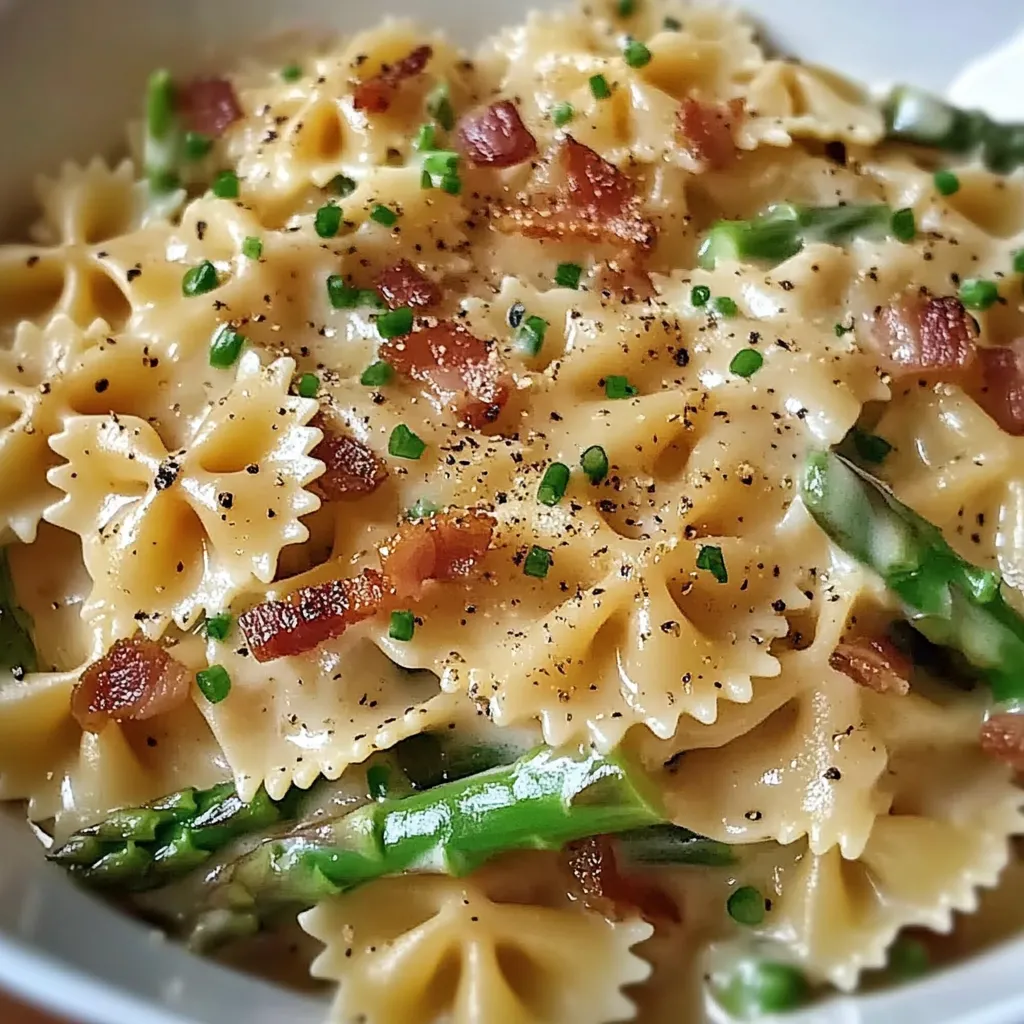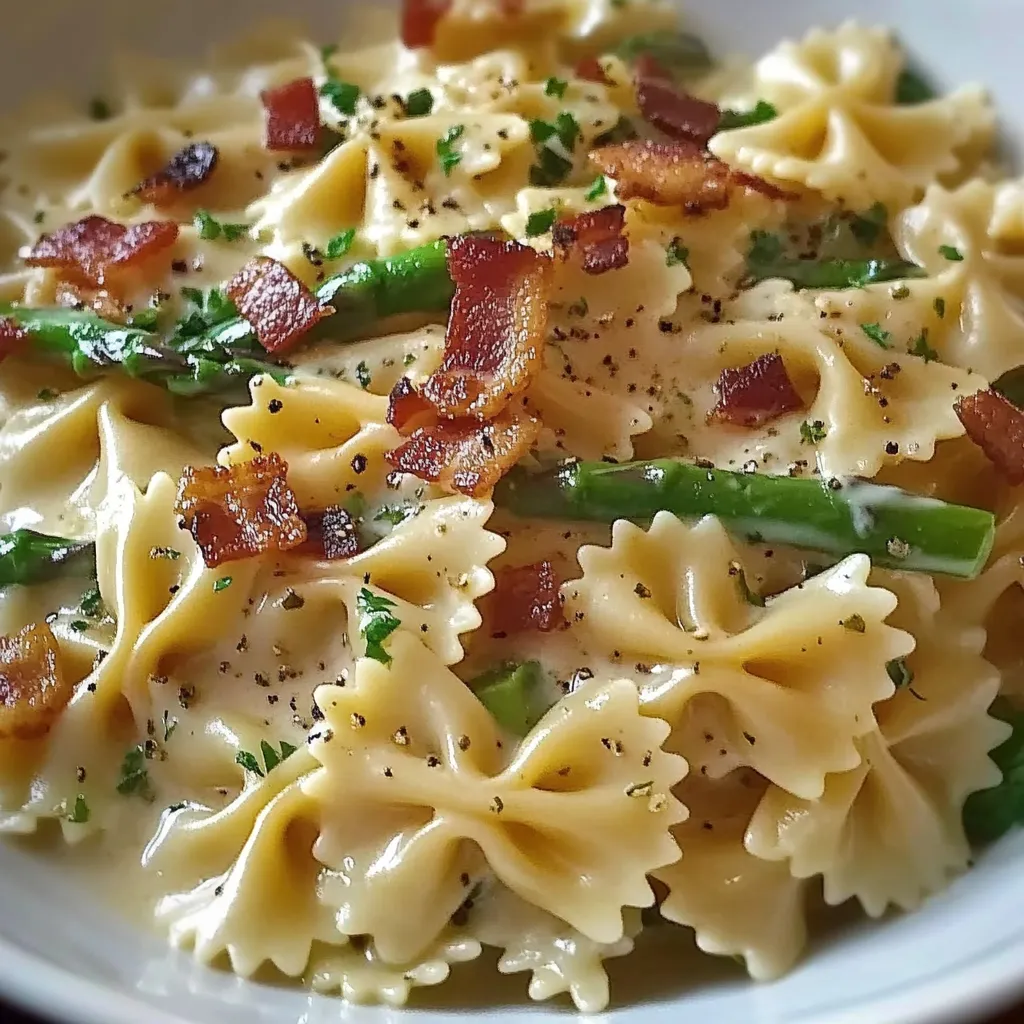 Save
Save
Velvety sauce clings to perfectly cooked bow tie pasta while tender-crisp asparagus adds vibrant color and earthy freshness in this simple yet sophisticated dish. The rich, indulgent cream sauce creates the perfect backdrop for asparagus's distinctive flavor, allowing both elements to shine while complementing each other beautifully. This harmonious combination transforms basic ingredients into a restaurant-worthy meal that satisfies both comfort food cravings and the desire for seasonal vegetables.
The first time I made this pasta, it was during early spring when the first local asparagus appeared at my farmers market. I wasn't sure how the earthy flavor would pair with a cream sauce, but the combination was revelatory. The slight bitterness of the asparagus cut through the richness perfectly, creating something far greater than the sum of its parts. Now it's a seasonal tradition I look forward to every year.
Essential Ingredients
- Bow Tie Pasta: These sturdy shapes capture sauce in their crevices. The decorative form holds up well against the weight of the cream sauce while providing textural interest throughout the dish.
- Unsalted Butter: Creates the foundation for the sauce with rich, pure dairy flavor. European-style butter with higher butterfat content produces an even more luxurious result.
- Fresh Garlic: Adds aromatic depth that permeates the entire dish. Mince just before cooking to maximize the release of essential oils and flavor compounds.
- Parmesan Cheese: Contributes savory umami notes and helps thicken the sauce. Freshly grated cheese melts more evenly than pre-packaged varieties and delivers superior flavor.
- Chicken Soup Base: Provides concentrated savory foundation that enhances all other flavors. This ingredient creates depth without requiring lengthy reduction of stock.
- Heavy Cream: Creates the silky, rich texture that defines this dish. Its high fat content allows for stable emulsification with the cheese and prevents curdling during cooking.
- Asparagus: Brings fresh, grassy notes and vibrant color. Select spears of even thickness for consistent cooking, preferably on the thinner side for quicker blanching.
- Pine Nuts: Add buttery richness and textural contrast when toasted. Their subtle flavor complements both the cream sauce and the asparagus without overwhelming either component.
- Fresh Parsley: Provides bright color and herbaceous notes that cut through richness. The fresh flavor lifts the entire dish and prevents it from becoming one-dimensional.
Cooking Method
- Pasta Preparation:
- Bring a large pot of generously salted water to a rolling boil over high heat. Add bow tie pasta and cook according to package directions until al dente, typically 8-10 minutes, stirring occasionally to prevent sticking. The pasta should maintain slight resistance when bitten, as it will continue absorbing moisture from the sauce.
- Asparagus Blanching:
- While pasta cooks, prepare an ice bath in a large bowl. Bring a separate pot of water to a boil and add asparagus pieces, cooking for 2-4 minutes until bright green and tender-crisp. Immediately transfer to the ice bath to halt cooking and preserve vibrant color and texture.
- Sauce Foundation:
- Melt unsalted butter in a 9-inch skillet over medium heat until foaming subsides. Add minced garlic, stirring constantly to prevent browning, and cook until fragrant, about 60 seconds. The butter should take on the aromatic qualities of the garlic without allowing it to burn.
- Cheese Integration:
- Reduce heat to medium-low and add grated Parmesan cheese and chicken soup base, stirring continuously until cheese begins to melt. This gradual melting creates a smooth base for the sauce without clumping or greasiness.
- Cream Addition:
- Slowly pour heavy cream into the cheese mixture while stirring constantly. This gradual incorporation ensures proper emulsification and prevents separation. Season with salt and freshly ground black pepper, then allow sauce to gently simmer for 3-5 minutes until slightly thickened but still pourable.
- Component Combination:
- Add drained pasta directly to the sauce, tossing thoroughly to coat each piece. Gently fold in blanched asparagus pieces, being careful not to break them. The residual heat from the pasta and sauce will warm the asparagus without overcooking it.
- Final Touches:
- Sprinkle toasted pine nuts and chopped fresh parsley over the pasta, gently folding to distribute evenly. Transfer to serving plates and finish with additional freshly grated Parmesan cheese for an extra layer of flavor and visual appeal.
 Save
Save
My Italian grandmother taught me the secret to perfect cream sauce is patience—rushing the process inevitably leads to broken or grainy results. She would stand at the stove, wooden spoon in hand, gently stirring and watching for the exact moment when the sauce reached the perfect nappage consistency that would cling to the pasta without pooling. I still hear her voice in my head reminding me "piano, piano" (slowly, slowly) whenever I make cream sauces.
Elegant Accompaniments
This versatile pasta creates beautiful harmony with thoughtful wine pairings and complementary sides. A crisp, dry Sauvignon Blanc provides refreshing acidity that cuts through the richness of the cream sauce while highlighting the green notes in the asparagus. For red wine enthusiasts, a light-bodied Pinot Noir offers subtle earthiness that echoes the asparagus without overwhelming the dish.
Creative Variations
This adaptable recipe welcomes numerous interpretations while maintaining its essential character. For added protein, incorporate grilled chicken breast or sautéed shrimp during the final assembly. Vegetarians might appreciate additional vegetables like sweet peas or cherry tomatoes for contrasting color and flavor. Those following gluten-free diets can substitute rice-based pasta while maintaining the dish's creamy essence.
Keeping It Fresh
Store leftover pasta in airtight containers in the refrigerator for up to three days, maintaining both flavor and food safety. When reheating, add a splash of milk or cream to restore the sauce's silky texture, warming gently over medium-low heat while stirring frequently. Avoid microwaving if possible, as this can cause the sauce to separate and the pasta to become rubbery.
 Save
Save
After years of making this dish, I've found this creamy asparagus pasta represents the perfect balance between elegant simplicity and impressive results. The combination of silky sauce, perfectly cooked pasta, and vibrant asparagus creates a dish that feels special enough for entertaining yet simple enough for weeknight dinners. Whether enjoyed as a main course or alongside a protein, it showcases the best of seasonal spring produce while delivering the comfort we all crave from pasta dishes.
Common Questions About Cooking
- → Can I make this dish vegetarian?
- Yes, simply substitute the chicken soup base with vegetable bouillon or omit it altogether and add a little more salt and Parmesan for flavor.
- → How do I properly blanch asparagus?
- To blanch asparagus, bring a pot of salted water to a boil, add the cut asparagus pieces, and cook for just 1-2 minutes until bright green. Immediately transfer to an ice water bath to stop the cooking process, then drain well.
- → What can I substitute for pine nuts?
- If pine nuts are unavailable or too expensive, try using toasted walnuts, slivered almonds, or even sunflower seeds. Each will provide a different but complementary flavor and texture.
- → Can I make this ahead of time?
- This dish is best served fresh as cream sauces tend to thicken considerably when cooled and reheated. If you need to prepare components ahead of time, blanch the asparagus and toast the pine nuts, then make the sauce and pasta just before serving.
- → How can I make this recipe lighter?
- For a lighter version, substitute half-and-half or milk for the heavy cream (though the sauce won't be as thick). You can also reduce the amount of butter and Parmesan cheese, or use a light cream cheese to maintain creaminess with less fat.
